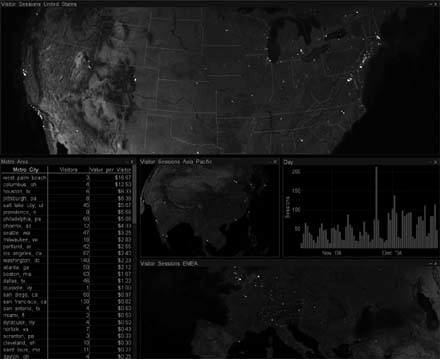Hack78.Track Your Geographic Visitor Distribution
Hack 78. Track Your Geographic Visitor Distribution
Knowing where your visitors reside can help focus online and offline marketing efforts. The Internet is great, because it completely breaks down geographic boundaries. Need information about the price of tea in China? Visit a Chinese web site to get the latest quotes! Need authentic Italian leather shoes? Visit http://www.rossetti.it for authentic Fratelli Rossetti shoes from Italy! Wherever you are in the world, you're only a click away on the Internet. Unfortunately, this works against marketers trying to connect more deeply with their online visitors. We live in a multichannel worldyou use the Internet but you also watch local television, read magazines and newspapers, and listen to the radioand the ideal marketing program will connect with you through as many channels as possible, thus increasing your brand awareness and likelihood to convert. Fortunately, many of the best measurement applications provide facilities to help you track the geographic distribution of your visitors. 5.12.1. Geographic Distribution ReportsWhile few vendors do quite as elaborate a job presenting the data as does Visual Sciences (Figure 5-17), geographic distribution reports are nearly ubiquitous in web measurement applications. These reports are usually limited to the number and percentage of visitors from each locale. The granularity of information is usually country, state, and city, but some vendors offer reporting at the area code, Zip Code, and Nielsen Media Research Designated Marketing Area (DMA; for more information about DMAs, see http://www.nielsenmedia.com/DMAs.html) 5.12.2. How Do They Do That?A visitor's geographic location can be inferred from her IP address. A number of "geo-targeting" services maintain databases of IP addresses that allow vendors to feed the IP address gleaned from either a server logfile or page tag to an API, which returns whatever geographic information they request. Some of the most popular services are:
Figure 5-17. High-end geographic reporting The most sophisticated solutions for geo-targeting have distributed networks of computers that probe IP addresses around the Internet using common network tools like PING, TRACEROUTE, and NSLOOKUP in tandem with complex algorithms for spatial comparison. Sounds ugly, huh? The end result is still a database of IP addresses mapped to physical locations, only now vendors can claim accuracy levels like 99 percent at the country level and 94 percent at the city level. Solutions like these are also able to resolve the observation that many web data analysts mistakenly makethe inference that the majority of their web visitors live in Vienna, Virginia, USA. Simply put, they don't. Vienna, Virginia is a bucolic suburb near Tyson's Corner, Virginia, only 15 miles from Dulles, VA, and as of the 2000 U.S. Census, Vienna was home to just over 14,000 residents. So how is a report like the one presented in Figure 5-18 even possible? The answer has to do with Vienna's proximity to Dulles, the corporate home of America Online, one of the world's largest dial-up Internet service providers, boasting 22.7 million subscribers in late 2004. A substantial majority of these folks use dial-up numbers that essentially route them through an AOL proxy server farm in, you guessed it, Vienna, Virginia. Figure 5-18. Sample WebTrends report If you're still seeing results like those in Figure 5-18, you should definitely call your measurement vendor and ask them how you can get better geographic data, data you can really use! 5.12.3. How to Really Use Geographic Distribution DataHere are some actions you can take based on your geographic distribution data:
This list is by no means exhaustive, but hopefully you get the idea. Keeping track of your visitors' geographic distribution is one of most powerful things you can do to really begin to know your visitors! If you have a significant offline presence (or are working to establish one), you may want to consider building a key performance indicator that tracks percentage-wise distribution of visitors from your target markets. |
EAN: 2147483647
Pages: 157